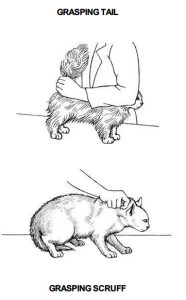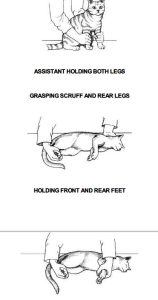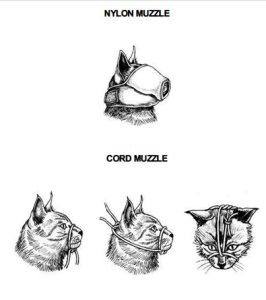RESTRAINT
Unlike well-trained and frequently handled dogs, most cats cannot be commanded to sit, stand, or lie quietly while unpleasant nursing procedures are performed. So to be successful in caring for your cat’s health at home you need to learn the best ways to provide restraint when necessary to avoid injury to yourself and your cat and to allow the nursing procedure to be carried out. Cats vary greatly in their personalities, and restraint must be tailored to the individual. The best general rule to follow is to use the minimum amount of restraint necessary to achieve your goal.
Never use two people when one is adequate, and always try the gentlest method first, unless you know from experience with the cat that very firm restraint is necessary. All the basic home nursing procedures explained in this section are described as if performed by one person, since most cats begin to struggle when firm restraint is applied and since gentle control is the least stressful for the cat. If you find that these simple methods don’t work for you, provide more firm control as necessary, but be sure to proceed firmly (not roughly) and deliberately or as the cat begins to object, you will lose your grip and may be scratched or bitten.
Never attempt treatment with the cat on the floor, on the bed, couch, or in your lap unless the cat is very cooperative. To achieve the best success place the cat on a smooth-surfaced table or other level platform that allows you to stand alongside. The simplest form of restraint involves the use of one hand and/or arm, leaving the other free for treatment. Light restraint includes placing one hand firmly over the cat’s shoulders while he or she lies down or placing a hand in front of the chest while the cat is standing or sitting, to prevent forward movement.
One arm wrapped around the cat’s body, so the cat’s head is held between your arm and body and so your hand can grasp his or her tail, provides good restraint for many procedures involving the rear legs and tail, as well as for taking a cat’s temperature (see illustration). For more control grasp the cat’s scruff (skin at the base of the neck) tightly and firmly or grasp the cat at the base of skull and press firmly with your thumb and fingers just below the ears. When using one of these methods, you can, if necessary, rest the arm of your restraining hand down on the cat’s back to give you greater control. If these simple holding methods fail and you have no one to help you, try rolling the cat in a towel or placing the cat in a pillowcase.
To give oral medication, allow the cat’s head to protrude, then follow the directions given for administering solid or liquid medicines. For other treatment just expose the area that needs care while leaving the rest of the cat covered. It is not always necessary to physically roll a cat in a towel. A towel just placed over an uncooperative cat often seems to provide a calming effect and will sometimes allow you to grasp and treat an otherwise “impossible” patient. If at any time during these or the following procedures the cat begins to pant or becomes visibly weaker, stop your restraint and allow the cat to regain strength and composure before proceding. Weak cats overly stressed by fighting restraint may collapse.
WRAPPED IN TOWEL
Having two people working together makes nursing a very uncooperative cat much easier. When giving oral medication, your assistant can wrap his or her arms around the cat and grasp the front legs firmly, applying downward pressure to prevent the cat from reaching up while you handle the head and mouth. Or your assistant can wield the towel if you find that it is easier to give treatment with the cat partially covered.
For other instances when firm restraint must be used your assistant can hold the cat in one of the following illustrated ways. Trimming the cat’s toenails prior to restraint can be helpful. Do not attempt any restraint procedures for cats if you are unwilling to risk a scratch or bite since even the most experienced veterinarian is occasionally injured when handling a difficult cat.
MAKING A MUZZLE
Although most veterinarians rarely muzzle a cat and the times you would have to do it are few, a muzzle can be very helpful when treating a cat whom you know bites or when moving an injured cat. A muzzle must be applied before attempting to move or handle the cat. It is difficult, if not impossible, to apply one properly to an already aroused and struggling cat.
The traditional muzzle is made from a long strip of cord, gauze bandage, or cloth. Form a loop and slip it over the cat’s nose as far as possible.
Draw the loop tightly around the nose with the ends under the chin. Then bring an end along each side of the cat’s head and tie them together firmly at the nape of the neck. Now slip one end of the bandage under the nose loop as illustrated, bring it back to the nape of the neck, and tie the ends tightly. If the muzzle is applied properly the cat’s biting efforts will be ineffective, and the muzzle itself may provide enough distraction for the cat for you to be able to complete the treatment.
Washable nylon muzzles that slip over the face of a cat and have quick release Velcro strap closures that wrap along the sides of the face and around the back of the neck are now commercially available. They are much easier and safer to apply to a fractious cat than the traditional type. Purchase one through your veterinarian or other pet supplier if your cat is uncooperative. Place it in your first aid kit for use in emergencies.


